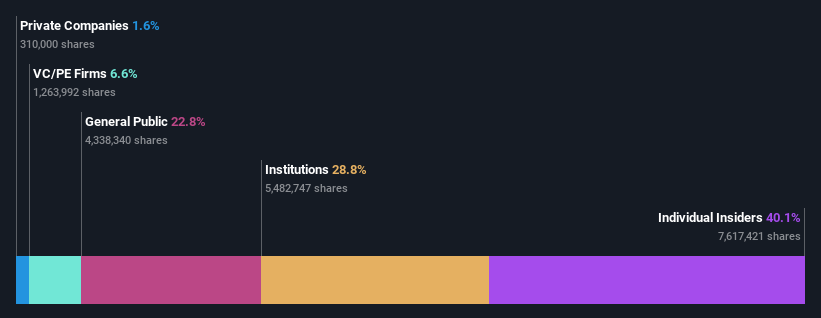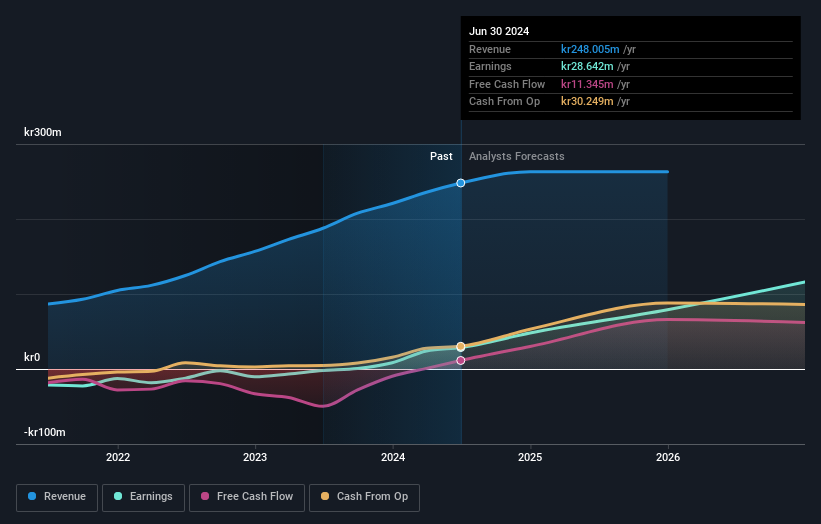- Sweden
- /
- Medical Equipment
- /
- OM:PAX
Paxman AB (publ) (STO:PAX) adds kr99m in market cap and insiders have a 40% stake in that gain

Key Insights
- Paxman's significant insider ownership suggests inherent interests in company's expansion
- 55% of the business is held by the top 4 shareholders
- 29% of Paxman is held by Institutions
To get a sense of who is truly in control of Paxman AB (publ) (STO:PAX), it is important to understand the ownership structure of the business. And the group that holds the biggest piece of the pie are individual insiders with 40% ownership. In other words, the group stands to gain the most (or lose the most) from their investment into the company.
As a result, insiders scored the highest last week as the company hit kr1.1b market cap following a 10% gain in the stock.
Let's take a closer look to see what the different types of shareholders can tell us about Paxman.
See our latest analysis for Paxman

What Does The Institutional Ownership Tell Us About Paxman?
Institutions typically measure themselves against a benchmark when reporting to their own investors, so they often become more enthusiastic about a stock once it's included in a major index. We would expect most companies to have some institutions on the register, especially if they are growing.
As you can see, institutional investors have a fair amount of stake in Paxman. This suggests some credibility amongst professional investors. But we can't rely on that fact alone since institutions make bad investments sometimes, just like everyone does. If multiple institutions change their view on a stock at the same time, you could see the share price drop fast. It's therefore worth looking at Paxman's earnings history below. Of course, the future is what really matters.

Hedge funds don't have many shares in Paxman. Looking at our data, we can see that the largest shareholder is Glenn Paxman with 30% of shares outstanding. Avanza Fonder AB is the second largest shareholder owning 12% of common stock, and Richard Paxman holds about 6.7% of the company stock. Richard Paxman, who is the third-largest shareholder, also happens to hold the title of Member of the Board of Directors.
To make our study more interesting, we found that the top 4 shareholders control more than half of the company which implies that this group has considerable sway over the company's decision-making.
While it makes sense to study institutional ownership data for a company, it also makes sense to study analyst sentiments to know which way the wind is blowing. There is some analyst coverage of the stock, but it could still become more well known, with time.
Insider Ownership Of Paxman
The definition of company insiders can be subjective and does vary between jurisdictions. Our data reflects individual insiders, capturing board members at the very least. The company management answer to the board and the latter should represent the interests of shareholders. Notably, sometimes top-level managers are on the board themselves.
I generally consider insider ownership to be a good thing. However, on some occasions it makes it more difficult for other shareholders to hold the board accountable for decisions.
Our most recent data indicates that insiders own a reasonable proportion of Paxman AB (publ). Insiders have a kr425m stake in this kr1.1b business. This may suggest that the founders still own a lot of shares. You can click here to see if they have been buying or selling.
General Public Ownership
The general public, who are usually individual investors, hold a 23% stake in Paxman. While this group can't necessarily call the shots, it can certainly have a real influence on how the company is run.
Private Equity Ownership
With a stake of 6.6%, private equity firms could influence the Paxman board. Some investors might be encouraged by this, since private equity are sometimes able to encourage strategies that help the market see the value in the company. Alternatively, those holders might be exiting the investment after taking it public.
Next Steps:
While it is well worth considering the different groups that own a company, there are other factors that are even more important.
I always like to check for a history of revenue growth. You can too, by accessing this free chart of historic revenue and earnings in this detailed graph.
If you are like me, you may want to think about whether this company will grow or shrink. Luckily, you can check this free report showing analyst forecasts for its future.
NB: Figures in this article are calculated using data from the last twelve months, which refer to the 12-month period ending on the last date of the month the financial statement is dated. This may not be consistent with full year annual report figures.
New: Manage All Your Stock Portfolios in One Place
We've created the ultimate portfolio companion for stock investors, and it's free.
• Connect an unlimited number of Portfolios and see your total in one currency
• Be alerted to new Warning Signs or Risks via email or mobile
• Track the Fair Value of your stocks
Have feedback on this article? Concerned about the content? Get in touch with us directly. Alternatively, email editorial-team (at) simplywallst.com.
This article by Simply Wall St is general in nature. We provide commentary based on historical data and analyst forecasts only using an unbiased methodology and our articles are not intended to be financial advice. It does not constitute a recommendation to buy or sell any stock, and does not take account of your objectives, or your financial situation. We aim to bring you long-term focused analysis driven by fundamental data. Note that our analysis may not factor in the latest price-sensitive company announcements or qualitative material. Simply Wall St has no position in any stocks mentioned.
About OM:PAX
Paxman
Develops and sells Paxman scalp cooling system to minimize hair loss in connection with chemotherapy treatment worldwide.
Exceptional growth potential with flawless balance sheet.


